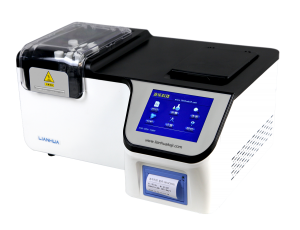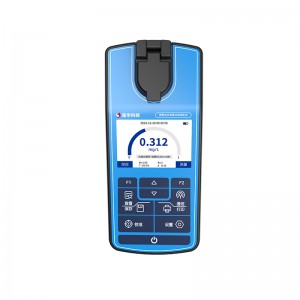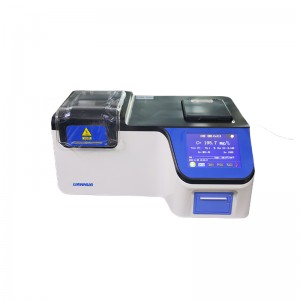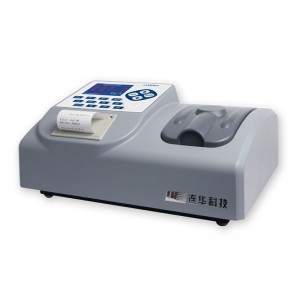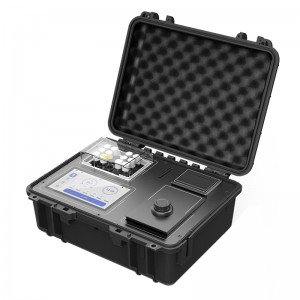UV Vis spectrophotometet multi-parameter water quality analyzer LH-S700
The wavelength range of LH-S700 is 190nm-1100nm, and its photometric performance meets the requirements of Level II in accordance with the "JJG178-2007 Verification Regulations for Ultraviolet, Visible, and Near Infrared Spectrophotometers". In order to meet the market demand for photometers, it has expanded its functions to include photometric measurement, quantitative measurement, dynamic analysis, wavelength scanning, multi wavelength testing, and multi parameter testing. It is an intelligent full band analysis instrument that can be used as both a UV visible spectrophotometer and a multi parameter water quality analyzer.
1. Comply with the Level II requirements of the "JJG-178-2007 Verification Regulations for Ultraviolet, Visible, and Near Infrared Spectrophotometers" and meet the detection needs of various fields;
2.190nm-1100nm full band scanning, with adjustable parameters such as scanning speed, interval step size, scanning frequency, and measurement indicators. It supports functions such as peak marking, valley marking, and spectral area calculation;
3. Multi wavelength measurement can add 1-8 wavelengths, each of which can be edited for wavelength, K value, calculated absorbance value, and curve formula;
4. Luminescence measurement can quickly adjust the wavelength, measure absorbance, transmittance, and energy values;
5. Quantitative analysis supports users to create their own curves, which can be used to establish linear fitting, polynomial fitting (binomial, trinomial), exponential fitting, logarithmic fitting curves, and can be saved and directly called up next time;
6. Perform dynamic scanning with time as the coordinate axis, select a wavelength to continuously scan the sample and observe the change curve between time, and observe the trend of sample change;
7. Built in multi parameter water quality detection function, more than 60 detection indicators, and more than 110 detection modes can be directly called. The instrument can be used as both a photometer and a multi parameter water quality analyzer;
8. The graph display is clear and supports free scaling, making it easy to visually view the trend of data changes;
9. With a memory space of 16g, it can store 100000 pieces of massive data, and each functional data can be independently saved. It supports filtering, management, analysis, and export, and can save Excel and PDF file formats;
10. Support one click wavelength calibration, manual zeroing, and dark current calibration, which can quickly adjust the optical path status of the instrument to ensure its accuracy and stability;
11. Tungsten lamp/deuterium lamp dual beam optical system, with an independent switch for the light source that can be activated as needed, effectively extending the lifespan of the light source and reducing maintenance costs;
12. Socket type tungsten lamp/deuterium lamp, quick insertion and replacement of light source, no need for optical debugging, equipment maintenance is simpler;
13. The screen brightness can be adjusted, with a screensaver function that supports 0-90 ° angle adjustment, making it easy for users to operate and providing clearer viewing angles, while also effectively protecting the screen;
14. Using Android architecture to build LHOS operating system, supporting multiple functions such as WIFI, Internet of Things, Chinese input, data filtering and analysis, making instrument use simpler and more intelligent;
15. Intelligent Internet of Things applications, supporting access to user owned databases or Lianhua Cloud for querying and big data applications, can remotely monitor and control instruments;
16. Real time protection monitoring of the system, hardware level detection of the system's operating status, saving records and performing automatic system recovery in case of abnormalities, supporting factory settings recovery and network update functions
17. Built in operation assistance function, which allows users to view instruction manuals, quick start guides, and operation videos for easy learning and use of the instrument. The instrument supports multitasking and can be viewed at any time during the testing process;
18. Color comparison upgrade, four column automatic color comparison, supports 1cm-5cm dish color comparison, 16mm tube color comparison methods, and users can customize color comparison dish specifications.
19. Equipped with HDMI interface, it can be connected to large screen demonstrations, suitable for scientific research and teaching use;
20. Built in thermal printer, automatic/batch printing, simple, convenient and efficient operation;
21. Operation guide assistance, built-in instrument usage tutorial, quickly grasp the operation process;
| Detection parameters | |||
| Instrument Name | uv-vis spectrophotometer | Instrument Name | LH-S700 |
| wavelength range | (190-1100)nm | wavelength range | 2.0nm |
| Equipment functions | Photometric measurement, quantitative measurement, kinetic analysis, wavelength scanning, multi wavelength testing, multi parameter testing | Equipment functions | ≤±0.2nm(190-340nm);
≤±0.5nm(340-1100nm) |
| Automatic calibration | With automatic calibration function | Automatic calibration | Automatic detection capability
Error alarm function
|
| wavelength accuracy | ±0.5nm(190-340nm);
±1.0nm(340-1100nm) |
wavelength accuracy | ≤0.2%(220nm、360nm)
≤0.5%(420nm) |
| Transmittance accuracy | ±0.5% | Transmittance accuracy | ≤0.2% |
| Wavelength Resolution | 0.1nm | Wavelength Resolution | ≤±0.002A |
| Noise | ≤0.1%(transmittance 0%)
≤0.2%(transmittance 100%) |
Storage | 16GB(100000+) |
| Physical parameters | |||
| Display | 10 inch color touch screen | Thermal line printer | |
| Colorimetric method | Four automatic dish color comparison+tube color comparison | Data transmission | USB |
| Instrument weight | 16.7Kg | External dimensions | (504×370×211)mm |
| Environment and working parameters | |||
| Ambient temperature | (5-40)℃ | Ambient humidity | Relative humidity ≤ 85% RH (without condensation) |
| Rated voltage | AC220V±10%/50Hz | Rated power | 80W |
| No. | Items | Analysis method | Measuring range(mg/L) |
| 1 | COD | Rapid digestion spectrophotometry | 0-15000 |
| 2 | Permanganate index | Potassium permanganate oxidation spectrophotometric method | 0.3-5 |
| 3 | Ammonia nitrogen Nessler | Nessler's reagent spectrophotometric method | 0-200(segmentation) |
| 4 | Ammonia nitrogen salicylic acid | Salicylic acid spectrophotometric method | 0.02-50 |
| 5 | Total phosphorus ammonium molybdate | Ammonium molybdate spectrophotometric method | 0-12(segmentation) |
| 6 | Total phosphorus vanadium molybdenum yellow | Vanadium molybdenum yellow spectrophotometric method | 2-100 |
| 7 | total nitrogen | Alkaline potassium persulfate digestion UV spectrophotometry | 0.1-100 |
| 8 | total nitrogen | Color changing acid spectrophotometric method | 1-200 |
| 9 | turbidity | Fulmazhen spectrophotometric method | 0-400NTU |
| 10 | chroma | Platinum cobalt color system | 0-500Hazen |
| 11 | Suspended solids | Direct colorimetric method | 0-1000 |
| 12 | copper | BCA photometric method | 0.02-50 |
| 13 | copper | Diketoxime spectrophotometric method | 0.04-80 |
| 14 | iron | Phenanthroline spectrophotometric method | 0.01-50 |
| 15 | nickel | Dimethylglyoxime spectrophotometric method | 0.1-40 |
| 16 | nickel | Dihydroxime spectrophotometric method | 0.04-60 |
| 17 | hexavalent chromium | Diphenylcarbazide spectrophotometric method | 0.01-5 |
| 18 | total chromium | Diphenylcarbazide spectrophotometric method | 0.01-5 |
| 19 | total chromium | Phenylhydrazine spectrophotometric method | 0.1-10 |
| 20 | lead | Xylenol Orange spectrophotometric method | 0.05-50 |
| 21 | zinc | Zinc reagent spectrophotometric method | 0.1-10 |
| 22 | cadmium | Dithizone spectrophotometric method | 0.1-5 |
| 23 | manganese | Potassium periodate spectrophotometric method | 0.01-50 |
| 24 | silver | Cadmium reagent 2B spectrophotometric method | 0.01-8 |
| 25 | antimony | 5-Br-PADAP spectrophotometric method | 0.05-12 |
| 26 | cobalt | 5-Chloro-2- (Pyridylazo) -1,3-Diaminobenzene spectrophotometric method | 0.05-20 |
| 27 | nitrate nitrogen | Color changing acid spectrophotometric method | 0.05-250 |
| 28 | Nitrite nitrogen | Naphthalene ethylenediamine hydrochloride spectrophotometric method | 0.01-6 |
| 29 | sulfide | methylene blue spectrophotometry | 0.02-20 |
| 30 | sulfate | Barium chromate spectrophotometric method | 5-2500 |
| 31 | phosphate | Ammonium molybdate spectrophotometric method | 0-25 |
| 32 | phosphate | Vanadium molybdenum yellow spectrophotometric method | 6-3000 |
| 33 | fluoride | Fluorine reagent spectrophotometric method | 0.01-12 |
| 34 | cyanide | Barbituric acid spectrophotometric method | 0.004-5 |
| 35 | Residual chlorine | N. N-diethyl-1.4 phenylenediamine spectrophotometric method | 0.1-15 |
| 36 | Total residual chlorine | N. N-diethyl-1.4 phenylenediamine spectrophotometric method | 0.1-15 |
| 37 | chlorine dioxide | DPD spectrophotometric method | 0.1-50 |
| 38 | ozone | Indigo spectrophotometric method | 0.01-1.25 |
| 39 | silica | Silicon molybdenum blue spectrophotometric method | 0.05-40 |
| 40 | formaldehyde | Acetylacetone spectrophotometric method | 0.05-50 |
| 41 | aniline | Naphthalene ethylenediamine hydrochloride azo spectrophotometric method | 0.03-20 |
| 42 | nitrobenzene | Determination of total nitro compounds - spectrophotometric method | 0.05-25 |
| 43 | Volatile phenol | 4-aminoantipyrine spectrophotometric method | 0.01-25 |
| 44 | Anionic surfactant | Methylene blue spectrophotometric method | 0.05-20 |
| 45 | Hydrazine (hydrazine) | Dimethylaminobenzaldehyde spectrophotometric method | 0.05-10 |
| 46 | Methyl hydrazine | Dimethylaminobenzaldehyde spectrophotometric method | 0.015-25 |
| 47 | udmh | Sodium ferrocyanide amino spectrophotometric method | 0.1-20 |
| 48 | alkalinity | Methyl orange spectrophotometric method | 20-400 |
| 49 | Magnesium hardness | Calcium magnesium reagent spectrophotometric method | 0-80 |
| 50 | calcium hardness | Calcium magnesium reagent spectrophotometric method | 0-80 |
| 51 | Total Iron | Phenanthroline spectrophotometric method | 0.2-100 |
| 52 | Volatile fatty acids | Esterification spectrophotometry | 20-3600 |
| 53 | chloride | Mercury thiocyanate high-speed iron spectrophotometric method | 0.1-25 |
| 54 | trace arsenic | New silver salt spectrophotometric method | 0~0.012 |
| 55 | Arsenic | Ag (DDC) spectrophotometric method | 0~5 |
| 56 | Total mercury | Mercury dithizone photometric method | 2-40 |
| 57 | boron | Curcumin photometric method | 0~20 |
| 58 | iodide | Catalytic colorimetric method | ≥0.01mg/L |
| 59 | carbon disulfide | Diethylamine copper acetate spectrophotometric method | 0-15 |
| 60 | triethylamine | Bromophenol blue spectrophotometric method | 0-0.4 |
| 61 | Thiocyanate | Isonicotinate pyrazolone spectrophotometric method | 0-15 |
| 62 | beryllium | Chromium cyanide R spectrophotometric method | 0-40 |
| 63 | Trichloroacetaldehyde | Pyrazolinone spectrophotometric method | 0-20 |
| 64 | vanadium | Tantalum reagent (BPHA) extraction spectrophotometric method | 0-100 |
| 65 | barium | Chromate indirect spectrophotometric method | 0-30 |
| 66 | uranium | TRPO-5-Br-PADAP photometric method | 0-16 |
| 67 | thorium | Uranium reagent III photometric method | 0-30 |






